Florence, often hailed as the ‘Cradle of the Renaissance,’ is one of Europe’s most stunning and lively cities.
Each year, millions of visitors flock to the city, drawn by its incredible art and architecture.
But what if you’re a repeat visitor to Florence or prefer to escape the constant buzz of tourists?
In that case, let me introduce you to some of Florence’s hidden gems. These lesser-known spots offer breathtaking Renaissance art without the crowds and long lines.
Here, you can enjoy groundbreaking paintings, sculptures, and frescoes at your own pace, free from the jostling crowds and without anything blocking your view.
Tip: You can also book a 3 hour guided tour of Florence’s hidden gems or book a 3 hour guided tour of both the highlights and hidden gems.
Hidden Gems & Secret Spots in Florence
1. Chapel of the Magi | Capella dei Magi
The Chapel of the Magi is located in the Medici-Riccardi Palace, the first of three palaces that the Medici family lived in. The palace itself is rather a brooding rusticated stone affair.
But upstairs in the piano nobile hides one of the most precious hidden gems in Florence — the Chapel of the Magi.
It’s accessed via a stairway from the courtyard. When I last visited, I was the only one there!
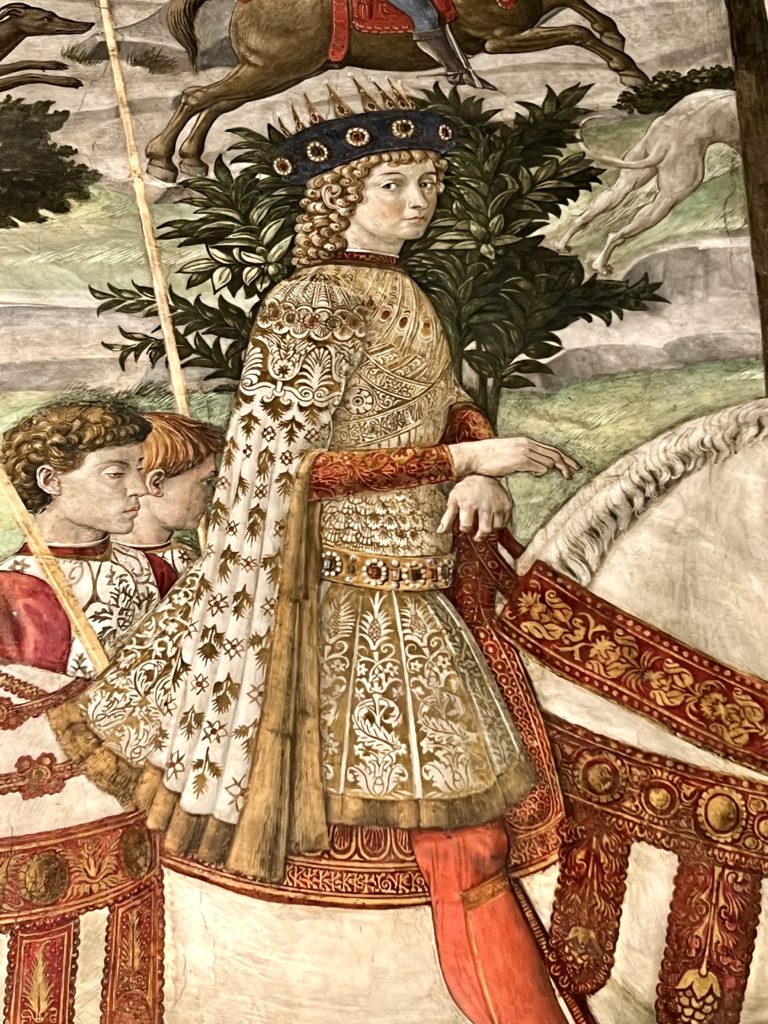
The Chapel of the Magi was a private chapel used exclusively for the Medici’s prayer and devotion.
The chapel is decorated with a beautiful series of frescos painted in 1459 by Benozzo Gozzoli. Gozzoli was trained by Ghiberti and Fra Angelico, and thus developed a charming narrative style.
The frescos are in two parts, the Procession of the Magi on three walls in the main room and the Adoration of the Magi in the chancel. The frescos are meant to glorify the Medici family.
It was a form of propaganda to show their wealth and greatness. Throughout the chapel, there’s an abundance of purple porphyry and gold, just to underscore the point.
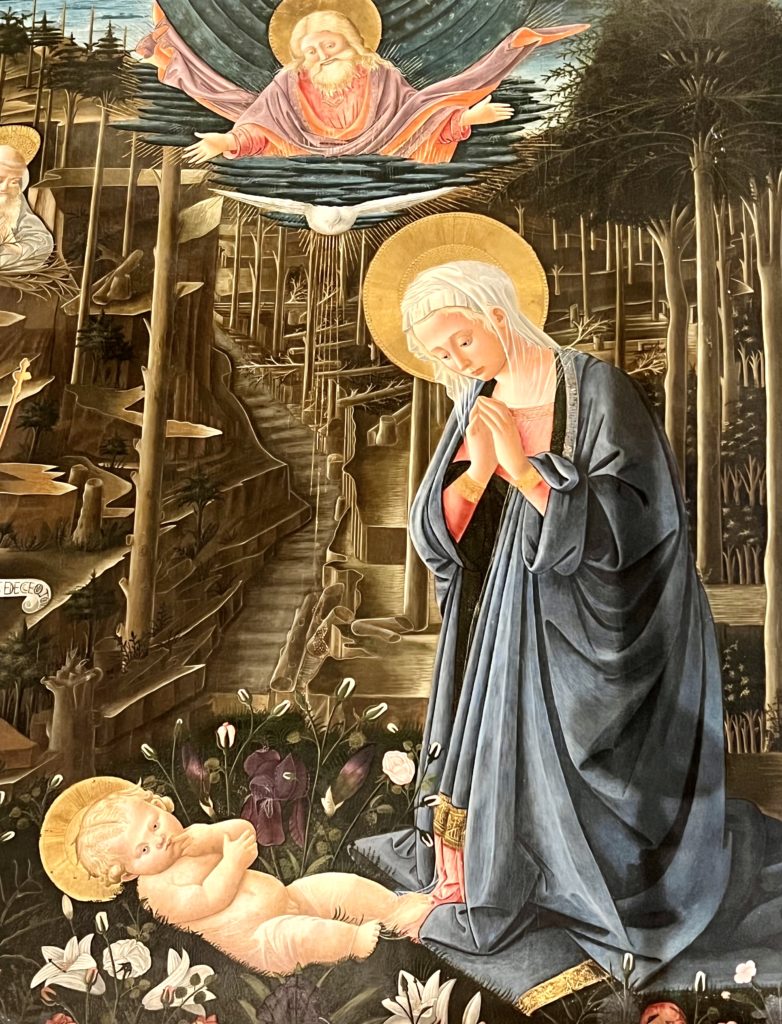
The Procession of the Magi covers three of the four chapel walls. Each wall represents one of the three kings or magi arriving in Bethlehem to pay homage to the newborn king, bringing expensive gifts.
Famous Medici appear in the guise of the magi, equating themselves with immortality.
On the east wall, there’s a portrait of Lorenzo the Magnificent at the age of 10 on a white horse. There’s also a portrait of Giuliano, Lorenzo’s brother who was assassinated in the Pazzi Conspiracy.
Cosimo the Elder appears riding a donkey, a reference to Jesus himself. Is Cosimo trying to appear modest or as the second coming? It’s delightfully unclear.
2. Basilica of Santo Spirito
The Basilica of Sant Spirito is Brunelleschi’s second church in Florence. It’s a Florence hidden gem, sitting in a shabby chic piazza in the Oltrarno district.
Built in 1440, the church is a pivotal work of the early Renaissance. Brunelleschi was one of the first architects to use perspective and geometry, breaking away from outdated medieval church styles.
Brunelleschi thought beauty resided in harmony and mathematical perfection.
He was inspired by the classicism of ancient Rome, creating an unassuming exterior and a rather severe interior. Brunelleschi used a latin cross (like a small t) floorpan.
The main altar, an out of place Baroque affair, is at the center of the crossing square.
Three sides of Santo Spirito have a continuous succession of 40 identical semi-circular chapels. The massive pietra forte Corinthian columns give the church a monumentality.
Santo Spirito houses a wooden crucifix attributed to Michelangelo. It was carved when the artist was only 17.
Restored, it now hangs 22 meters high in the sacristy designed by Lorenzo the Magnificent’s favorite architect Giuliano da Sangallo. For 3 euros, you can access the sacristy from the cloister and see the crucifix in the round.
There are also some notable frescos in the Bini-Capponi Chapel. And art lovers will should inspect Domenico di Zanobi’s Maddona of the Relief in the Velutti Chapel.
3. Bardini Gardens
The Bardini Gardens are situated between Costa San Giorgio and Borgo San Niccolo. They’re close to the more famous Boboli Gardens of the Pitti Palace, but much less crowded.
Beginning in the 13the century, the gardens belonged to the Mozzi family.
In the 20th century, famous art dealer Stefano Bardini purchased the villa, gardens, and the surrounding properties. The gardens officially opened to the public in 2005, after a massive restoration.
The Bardini Gardens contains four hectares of woods, cypress trees, gardens and fruit orchards. It’s the perfect serene environment to take a relaxing stroll or stop to read a book.
The most famous spot is the whimsical Wisteria Tunnel of purple flowers (show at the top). If you go to the gardens in mid-April/May, the wisteria will be in peak bloom.
The best spot for views is from the Belvedere terrace, where you get a panoramic view of the Florentine cityscape.
Click here to take a tour of both the Bardini and Boboli gardens.
4. Orsanmichele | San Michele in Orto
Designed by Francesco Talenti and others, Orsanmichele is a wonderful hidden gem in Florence. It’s a well preserved and important 15th century Florentine church. It’s eccentric looking. Orsanmichele rises up like a three story brown rectangle.
But it’s a treasure trove of Renaissance sculpture — a sort of street view museum. Orsanmichele was originally Florence’s central grain market. It was converted into a church in 1380.
Inside, the church has a spectacular bejeweled Gothic Tabernacle altar, with a painting of the Madonna della Grazie. Legend holds that those who prayed before her were granted miracles. The original painting was lost and replaced with a 1497 painting by Bernardo Daddi.
Orsanmichele is most noted for its incredible sculpture, decorating the exuberant Gothic facade. The facade has 14 niches, each one housing a statue of a patron saint commissioned by Florence’s guilds.
Created by the best artists of the time, the exterior sculptures are now copies, with the monumental originals in the Orsanmichele Museum on the top floor of the church.
By far, Orsanmichele’s most famous sculpture is Donatello’s St. Mark. It’s the first truly Renaissance piece of art (sculpture was more advanced than painting). St. Mark marked a revival of classical themes and naturalism.
St. Mark was even given a receding hairline. Donatello’s famous St. George was also once at Orsanmichele, but was moved to the Bargello Museum.
Orsanmichele also has three sculptures by Ghiberti — St. John the Baptist (the first significant Renaissance statue in bronze), St. Matthew (Ghiberti’s most important sculpture), and St. Stephen. And also a famous sculpture by Andrea Verrochio, Doubting Thomas.
Right now, the Orsanmichele Museum is only open on Monday morning from 10:00 am to 12:30 pm and Saturday from 10:00 am to 5:00 pm.
5. Stibbert Museum and Garden
Perfect for history and military buffs, the Stibbert Museum is one of Florence’s more unusual museums. It houses the private collection of eccentric art collector Frederick Stibbert.
When Stibbert inherited a fortune, he retired. Collecting art became his passion. Hard life, huh?
When Stibbert died, he gifted his villa to Florence. His museum is filled with an eclectic collection of artifacts, especially armory and weaponry, spread over 57 rooms. One of the most important pieces is the “pwit costume,” made for the coronation of Napoleon as king of Italy in 1805.
Be sure to wander through the Medieval Room and the Hall of Knights. The latter has full scale replicas of horses and armory. That room’s only beat by the sheer number of samurai swords.
The Stibbert Museum also has a beautiful garden. It’s a romantic English style garden with quirky architectural elements, filled with caves, temples, and fountains.
There are two ponds with a variety of aquatic life. Apart from admiring the flora and fauna, there are two temples.
One is a Hellenistic temple. The other is an Egyptian Temple, built by Stibbert himself between 1862-64. Both temples recall the 19th century fashion for all things antiquity.
6. Duomo Museum | Opera del Duomo Museum
The newly renovated Opera del Duomo Museum is an absolute must visit attraction in Florence. Everyone visits the Duomo, but very few go inside the museum. That’s a mistake because it’s spectacular.
The Duomo Museum is housed in the Piazza del Duomo at the back of Giotto’s Bell Tower, and offers a nice view of Brunelleschi’s dome from its terrace.
The museum houses works that were removed from the Duomo complex or brought in from outside for conservation. With 750 pieces, it’s the world’s largest collection of monumental Florentine sculpture.
The first thing you see when you walk in the museum is the Hall of Paradise. The hall contains a magnificent reconstruction of a Duomo facade.
It was torn down in 1587 to make room for a Renaissance facade (that was never completed). The reconstructed facade has exact replicas of the sculptures that once adorned it.
The other must see masterpieces in the Duomo Museum are Ghiberti’s Gates of Paradise (the world’s most famous doors), Michelangelo’s unfinished Florence Pieta, and Donatello’s compelling Penitent Magdalene.
You can visit the Duomo Museum with a Brunelleschi ticket to the Duomo complex. Click here for a guided tour of the magnificent Duomo Museum.
7. Opera Museum of Sante Croce Basilica
The Basilica of Santa Croce isn’t a hidden gem in Florence. The beautiful basilica has one of the world’s greatest assemblages of frescos, painting, sculptures, and celebrity funeral tombs (including Michelangelo’s).
But most people don’t make it to Santa Croce’s museum, the Museo dell’Opera di Santa Croce. Founded in1900, the Santa Croce Museum is in the church’s former Refectory. It houses works from the Florentine school.
In 1966, the space was damaged by catastrophic flooding of the Arno River. It was carefully restored, though some damage was irreversible. The museum reopened in 1975.
In the museum, you’ll find many impressive frescos, sculptures, sketches, etc.
The must see masterpieces include Cimabue’s Crucifix, Donatello’s St. Louis of Toulouse, Taddeo Gaddi’s The Last Supper and the Tree of Life, Bronzino’s Christ’s Descent into Limbo, and Francesco Salviati’s Deposition from the Cross.
There’s also a beautiful collection of terra-cotta tile by the Della Robia School.
Click here if you want to pre-purchase a skip the line ticket. Click here to book a 1 hour guided tour of the magnificent church.
8. Hospital of the Innocents
The Hospital of the Innocents is a museum dedicated to the first orphanage in Florence. This landmark building was designed by the famous architect Brunelleschi. You can book a 1.5 hour guided tour to take it all in.
It was his very first project. His resurrection of a classical style would establish a foundation for Italian architecture for centuries.
The museum was recently renovated and modernized. The museum uses a lot of digital and multi-media equipment to relay the history of the orphanage.
The most moving part of the museum is the objects parents left behind with their child, such as a broken locket. The objects were meant to be proof of parentage once the parent and child were reunited.
But sometimes the parent never returned. The objects are a bleak reminder of the child’s dire situation.
The building’s facade is covered with a nine bay loggia, and is slightly elevated with a staircase. There are concave circular frames set within spandrels between the loggias.
Four decades after Brunelleschi’s death, the ten “bambini” of Della Robbia — glazed relief sculptures of babies wearing swaddling clothes — were added. Nine triangular topped windows sit above the arches.
Inside you’ll find a women’s courtyard and a mens courtyard. The refectory, cloisters, dormitories, infirmary, and porticoes were purposely balanced by Brunelleschi to create a harmonious and rational hospital architecture.
Later, the rooms were enlarged and decorated with frescoes. The frescos depict the activities of the institution and the favors granted by the Medici dynasty.
The Hospital of the Innocents also has a fine art collection. It’s on the top floor gallery. There, you’ll find works by Fra Angelico, Botticelli, Ghirlandaio, Giambologna, and Della Robbia.
Probably the most famous painting is Ghirlandaio’s Adoration of the Magi.
Don’t miss the Madonna with Child attributed to a young Botticelli, who was obviously still under the influence of his brilliant master Filippo Lippi (whose quite similar Madonna and Child is in the Uffizi Gallery).
You may want to book a guided tour to get the full scoop.
9. Basilica of San Miniato al Monte
Most people head to Piazzale Michelangelo for the best views of Florence. But if you’re willing to hike a little higher, maybe 5 more minutes, you’ll find one of Florence’s most beautiful and best preserved ancient churches, the Basilica of San Miniato al Monte.
The basilica is Florence’s crowning glory, with even better views. Building began in 1018. Like the Baptistry, the church is over 1000 years old.
The church takes its name from Minias, an Armenian prince who was Florence’s first martyr. Legend holds that Minias picked up his decapitated head and flew over the Arno to the church site. San Miniato Church is dedicated to the saint.
The relics of Minias are often said to be buried in the church crypt, which features frescos by Taddeo Gaddi. But that’s inaccurate. The bones were sold off to raise money for the church. So I’m not sure what’s in the crypt besides chicken bones.
San Miniato has Florence’s emblematic white and green marble facade. It’s a harmonious piece of Tuscan Romanesque architecture, a very unique building in Florence.
When you walk through the turquoise doors, you’re greeted by a spectacular interior. Every inch of the church is covered in mosaics, gold leaf, or geometric patterns, with a spectacular mosaic decorating the half dome in the apse. The marble floor is decorated with zodiac signs.
The monks of San Miniato still sing Gregorian chants at Vespers, in a small chapel at the back of the church. Anyone can go and listen. They usually chant at 5:30 pm in the summer and 4:30 pm in the winter.
Click here to book a 2 hour guided tour of the ancient church.
10. Michelangelo’s Laurentian Library
Commissioned by Pope Clement VII, the Laurentian Library is a revolutionary and blissfully uncrowded masterpiece. Construction began in 1524 and the library opened in 1571. It now functions as a museum, not a library. It’s part of the Basilica of San Lorenzo complex.
The Laurentian Library consists of a reading room and a 48 foot vestibule built atop the San Lorenzo cloisters. It houses one of the world’s most important collections of manuscripts, which belonged to the Medici family.
In designing the library, Michelangelo broke away from classical tradition and rules of proportion. He designed a dream-like space with curves and unusual configurations.
The seemingly oversize Triple Staircase conveys a sense of movement. It seems to pour forward like pools of liquid. It may be the first freestanding staircase in architectural history.
The Laurentian Library features a dramatic staircase surrounded by extraordinary structures, so much so that the walls almost fade into the background. These walls are adorned with bold architectural elements, including oversized, low-hanging brackets.
Many of these features are set into niches, turning the architecture itself into a form of art. Columns are either embedded into the walls or seem to rest on the corbels, creating a unique visual effect.
In contrast to the dynamic vestibule, the Reading Room stretches out horizontally. It houses two rows of wooden benches, known as plutei, and is adorned with a striking white and red terra cotta floor and a beautifully designed coffered ceiling.
Michelangelo’s bold and innovative architectural style in the library was a precursor to Mannerism, a late Renaissance movement that brought a stylized and imaginative twist to classical design principles
11. The Chiostro dello Scalzo
The little known Cloister of the Scalzo is a meditative space in Florence just around the corner from San Marco Monastery. It’s a blissfully empty space without the cacophony of crowds at Florence’s usual hotspots.
This small hidden gem isn’t always open, so check the website for official hours. But it is always free.
The cloister itself was designed by celebrated architect Giuliano da Sangallo. Amid the elegant architecture are the beautiful frescos painted by High Renaissance and Mannerist painter Andrea del Sarto — known as the “faultless painter” — and his friend and fellow painter Fraciabigio.
Michelangelo was a del Sarto fanboy and del Sarto went on to teach Giorgio Vasari.
The frescoes are in monochromatic pigments, called the grisaille, style, which focuses the viewer’s attention on the beautiful drawing techniques employed. They depict twelve scenes from the life of St. John the Baptist and the four allegories of Charity, Hope, Justice and Faith.
The frescos were painted at various times from 1509-1526. Del Sarto’s style is marked by a sophisticated informality and natural expression of emotion.
12. Casa di Dante | Dante’s House
The Casa di Dante is supposed to be an exact replica of the house Dante lived in in Florence. Dante Alighieri is Italy’s famed 13th century poet. He’s the author of the acclaimed The Divine Comedy.
In this epic poem, Dante creates a fictional version of himself, traveling through hell, purgatory, and paradise. His image driven descriptions were hugely influential, producing a plethora of visual art.
Dante famously fell in love with Beatrice Portinari, writing about her as an idealized love in his Vita Nuova. But it was an unrequited love.
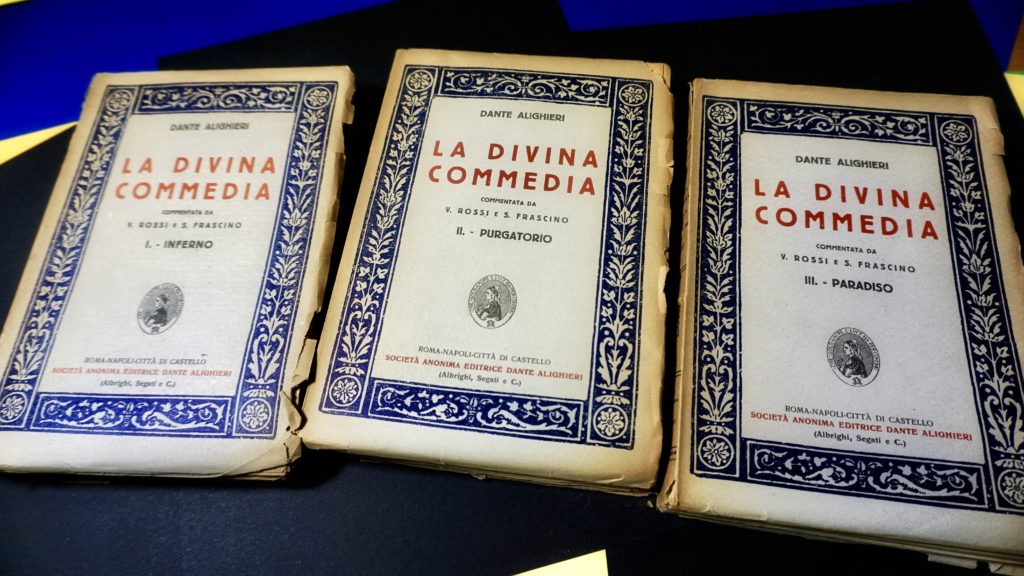
Dante admired her from afar. His passion became the subject of many paintings by Pre-Raphelite artists, especially Dante Gabriel Rossetti.
If you have an abiding fascination with the great 13th century poet, you’ll probably be interested in the displays. There are many copies of The Divine Comedy. Nearby is the church where Beatrice attended mass.
Click here to book a Dante-Inferno tour that includes Dante’s House.
13. Archaeolgical Museum
If you need a break from Renaissance art, head to Florence’s Archaeological Museum, housed in the Palazzo della Crocetta. It has an important archaeological collection, with a focus on the Etruscan period.
The museum’s most famous piece is the Arezzo Chimera, a bronze hybrid figure of a mythical lion-goat-serpent. The piece is truly ancient, dating back to the 4th century B.C. But it wasn’t discovered until the 16th century, pulled out of the earth in Arezzo in 1553.
When it was discovered, Cosimo I, who had a collector’s taste for Etruscan art, recognized its value. He had architect and artist Giorgio Vasari authenticate it.
The sculptor and goldsmith Benvenuto Cellini (whose Perseus graces the Loggia dei Lanza) cleaned and restored the piece. Cosimo kept the chimera in his personal collection at the Palazzo Vecchio.
On the top floor is another intriguing bronze, Idolino. The museum also has a vast collection of pottery, funerary urns, and gem stones.
14. Buonomini di San Martino
This 700 year old church is an important medieval complex. The church, which can be visited for free, was the home of the Confraternity of the Buonomini di San Martino.
Buonomini literally translates as “good men.” A confraternity was an association of lay people who gathered together to pray and do charitable works.
Saint Martin of Tours is the saint most often associated with charity. Legend holds that he divided his cloak in two to share it with a beggar.
In the Buonomini’s oratory, the saint is represented in 2 frescoed lunettes, while 8 other lunettes represent the various works and good deeds of the charitable Buonomini men.
The lunettes were painted by an unknown artist in the school of Ghirlandaio in the early 1480s. They are similar style to the frescoes in the high chapel of Santa Maria Novella.
15. L’importuno di Michelangelo
The L’importuno is a little piece of street art attributed to Michelangelo. It’s a graffiti- like carving etched into a single stone of the Palazzo Vecchio, near the Uffizi Gallery. It’s a simple almost caricature-y outline of a man’s face.
It’s unclear why Michelangelo may have carved the piece. One story holds that it’s the face of a man who bored Michelangelo in conversation on a daily basis.
Another legend holds that it’s the face of a condemned prisoner executed in the Piazza della Signoria. Some even claim that Michelangelo carved it with his knife hidden behind his back.
In any event, it’s just proof that graffiti has been around since ancient times.
16. Delle Porte Sante Cemetery
If you’re looking for some crowd free views of Florence, instead of Piazzale Michelangelo head uphill to the Sacred Doors Cemetery. It’s right behind the Church of San Miniato al Monte.
This ancient graveyard is an open air museum, stuffed with beautiful funeral art and memorials.
The private temples and tombs are in varying architectural styles, from Renaissance to Art Deco. Many of them are inspired by Florence’s churches.
The most famous effigy (show above) depicts the Mazzone siblings dancing together, fully united in the after life.
17. Buontalenti Grotto in the Boboli Gardens
The Buontalenti Grotto, also known as the Grotto Grande, is a fascinating but often overlooked spot in the Boboli Gardens of the Pitti Palace.
In 16th century Tuscany, it was the fashion to build decorative grottos reconstructing natural caves.
The title Buontalenti refers to the architect who designed this fantastical creation for Francesco I de’ Medici
On the sides of the pillared entrance are two niches with sculptures of Ceres and Apollo. They were sculpted by late Renaissance artist Baccio Bandinelli.
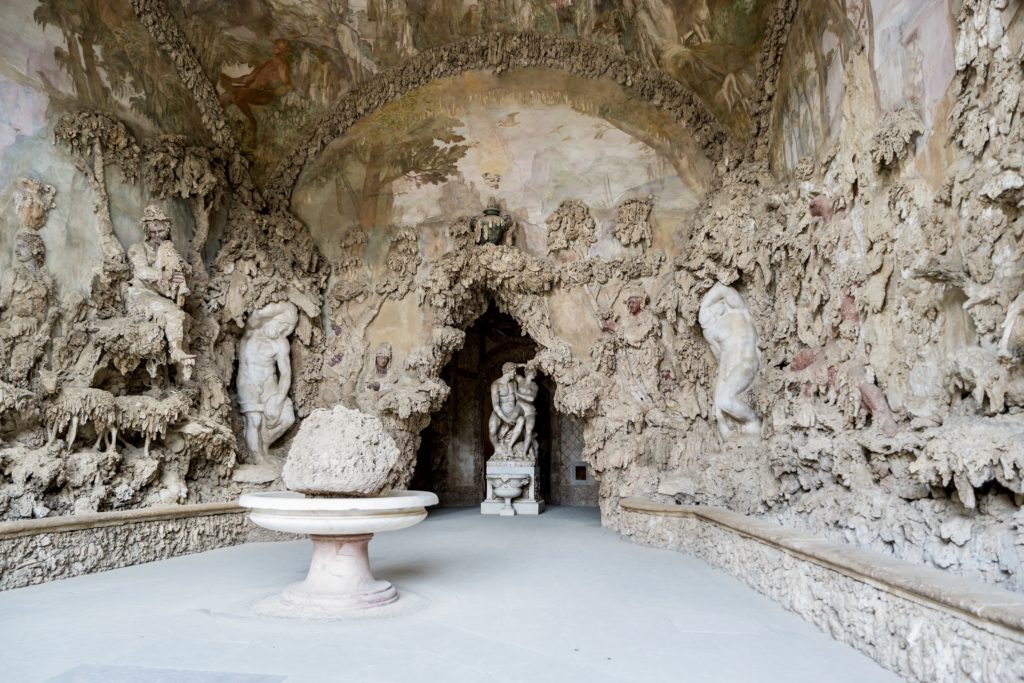
The fancy facade is overlaid with architectural elements that look like stalagmites. On the tympanum at the top, the Medici coat of arms is held by two mosaic figures symbolizing Peace and Justice.
Inside, the walls are lavishly decorated with fake stalactites, stalagmites, sponges, and shells, carved by Pietro Mati. One room has a hole, which was once a pond. The other two rooms have frescos and a fountain. A ceiling resembles a sky with flying birds.
Click here to pre-book a skip the line ticket to the Boboli Gardens. Click here to book a guided tour of the famous gardens.
18. Tower of Arnolfo
Want a great view of Florence without the queues and crowds? Instead of climbing Brunelleschi’s dome or Giotto’s Bell Tower, head to Palazzo Vecchio and climb the Tower of Arnolfo.
If you’re up for a climb of 418 steps, the Tower of Arnolfo offers panoramic 360 views of the Duomo and Florence.
You enter via the Museum of the Palazzo Vecchio, with a combined ticket for Palazzo Vecchio or for an additional small fee.
On your hike up, you’ll pass a prison cell known as the “Little Hotel.” This is where Cosimo the Elder and Savonarola were briefly imprisoned.
No more than 35 people can enter at once. On busy days, you’ll be limited to 30 minutes. In bad weather, it’s closed.
Click here to pre-book a ticket to Palazzo Vecchio. Click here to book a 1.5 hour guided tour with fast track ticket.
19. Museum of San Marco Monastery
If you want to see great art without the crowds, San Marco Monastery Museum is a perfect alternative to the Uffizi Gallery or the Accademia.
In 1437, Cosimo de Medici decided to rebuild a crumbling convent complex.
He hired the architect Michelozzo. The walls were decorated by Fra Angelico and his workshop. San Marco is now a haven of uplifting tranquility and home to some of Florence’s best sacred art.
Fra Angelico was a devout monk. With Giotto and Donatello, he helped transform the art world and usher in the Renaissance.
His humanistic pieces, with delicate palettes, led him to be dubbed the “Angelic Painter” or “Il Beato” (the Blessed). Giorgio Vasari described Fra Angelico as a “rare and perfect talent.”
The highlight of the San Marco Museum is the Sala dell’ Ospizio, where the most important Fra Angelico paintings are housed, including The Last Judgment, The Crucifixtion and Saints, and The Annunciation (at the top of the stairs).
There are also seminal works by Ghirlandaio, Michelangelo’s teacher, including a Last Supper fresco in the Refectory. Legend holds that the cherries arranged on the tablecloth spell out a rhyme.
READ: Guide To The Last Supper Paintings of Renaissance Italy
You can also visit the plain room where the fanatical monk Savonarola, the scourge of the Medici, lived and worked.
Also stop in to peer at the simple cell where Cosimo the Elder came to meditate. It’s decorated with Fra Angelico’s Adoration of the Magi.
Click here for a skip the line ticket. Click here for a fascinating tour that gives you insight into Fra Angelico, Savonarola, and the Medici.
20. Santa Maria Novella Pharmacy
While there’s a fee to enter the beautiful Basilica of Santa Maria Novella, you can visit the ancient pharmacy in a chapel right next door. Founded in 1221, its official name is the Farmaceutica di Santa Maria Novella.
It’s the world’s oldest apothecary still in operation. And it’s housed in a stunning building with vaulted ceilings, frescos, and ornate gilding and stucco.
In this ancient place, Dominican monks once slaved over herbal remedies and potions in the 13th century. They doused themselves in blended vinegar to protect them from the plague. In the 16th century, Catherine de’ Medici brought the pharmacy’s perfume, Eau de la Reine, to her French court.
Today, the pharmacy is a luxury store discreetly hawking beauty products with a cult following. Its products are handmade using Old World techniques. There’s also a small museum where you can view antique pharmaceutical instruments and pottery.
Click here for a tour of Santa Maria Novella and its ancient pharmacy.
21. Church and Museum of Saint Salvatore of Ognissanti
Near the Arno River is one of the most fabulous churches in Florence — Ognissanti.
The church and the convent were decorated by the greatest Early Renaissance masters of the times: Giotto, Botticelli, and Ghirlandaio. But because Ognissanti is off center, it doesn’t get many visitors.
The church was built in the 13th century. But it was completely remodeled in the 17th century in a Baroque style. Botticelli is buried here, along with his muse, Simonetta Vespucci.
There is some top notch art work for viewing in the church. The church originally held Giotto’s famous Ognissanti Madonna and Child Enthroned. But that painting was moved to the Uffizi Gallery.
You can still find Botticelli’s beautiful St. Augustine in His Study and Ghirlandaio’s St. Jerome and His Study, Madonna della Misericordia, and Lamentation.
Founded in 1251, Ognissanti was part of a monastery that, initially, was open to men and women.
The monastery was devoted to evangelical perfection, modesty, and manual labor. During Cosimo I’s reign, Franciscans took over the monastery in the 16th century.
The monastery was permanently closed in1866. Today, it’s a museum. You can visit the cloisters, the chapter house, and the refectory.
The museum’s claim to fame is Ghirlandaio’s fresco of The Last Supper on the back wall of the refectory.
Tip: You can only visit the museum for four hours (9:00 am to 1:00 pm) on Mondays and Saturdays, so make note of that when you are planning a visit.
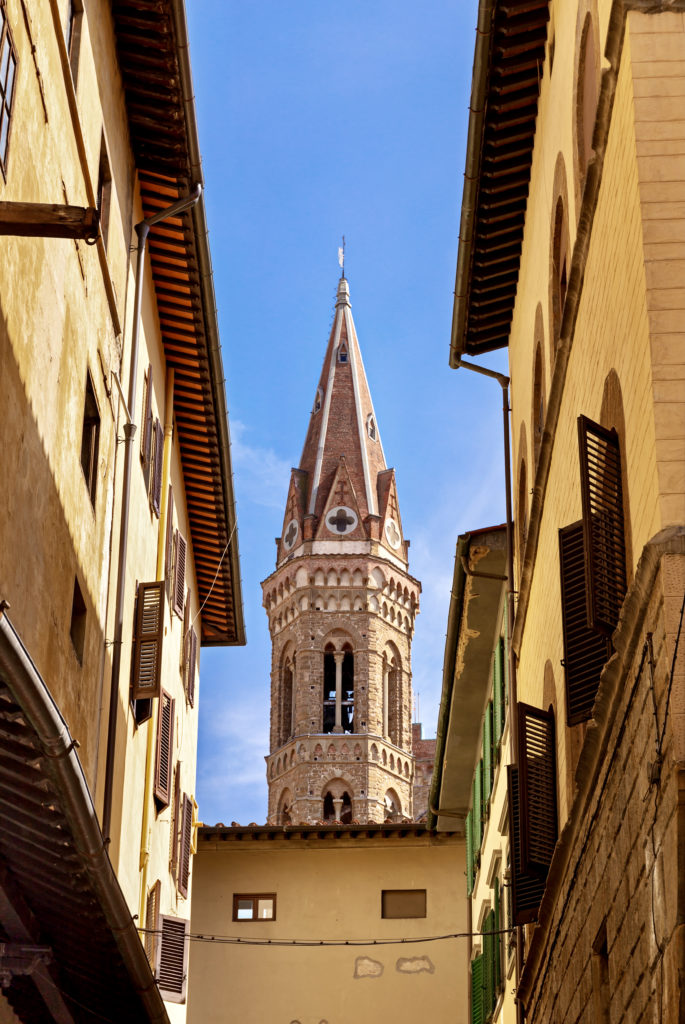
22. Badia Fiorentina
The Badia Fiorentina, or Florentine Abbey, is right near the Bargello Museum. Its presence is marked by a distinctive hexagonal bell tower, which is a prominent feature in Florence’s skyline.
Dante supposedly grew up across the street in what is now called the Casa Dante.
The abbey was founded in 978. In the 1280s, the abbey was rebuilt by Arnolfo di Cambio. The church was renovated in 1627 in a Baroque style.
The main thing to see in Badia Fiorentina is Filipino’s Lippi’s Apparition of the Virgin art to St. Bernard. Then, head down the stairs to the Cloister of the Oranges. Along with fruit trees, you’ll see some gorgeous frescos.
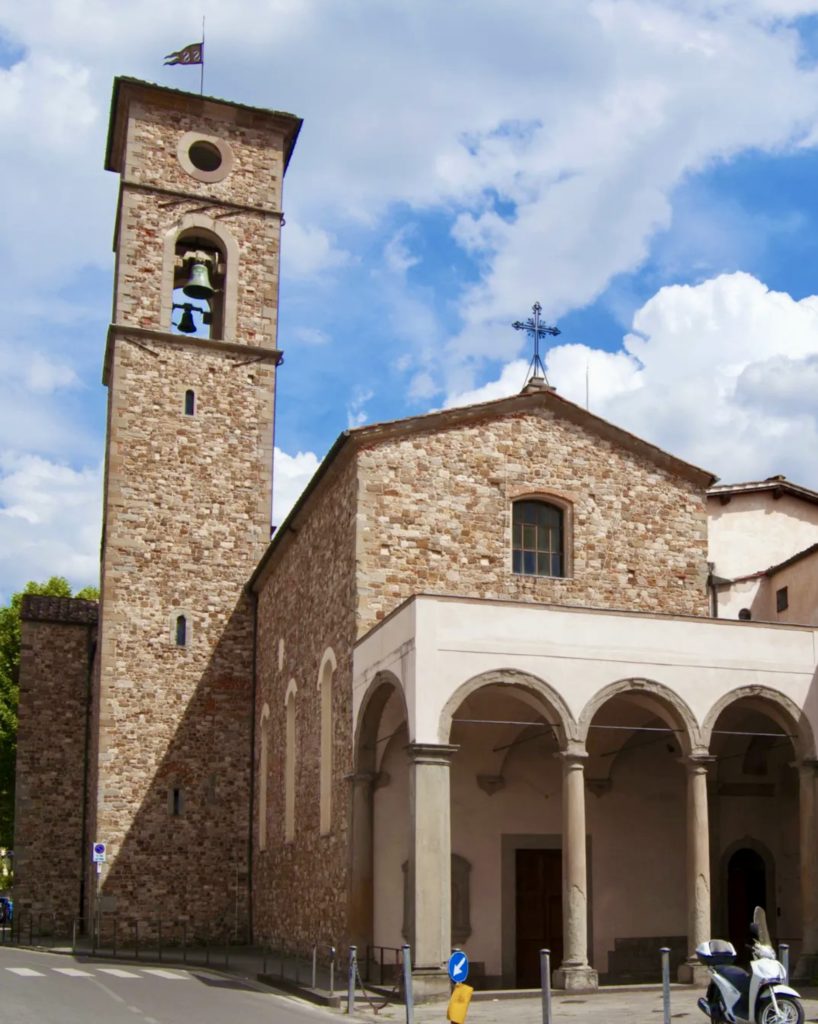
23. Church of San Salvi
The Chiesa San Salvi is located just outside the historic center of Florence. It’s a Vallombrosian church constructed in the 11th century.
The church is now a place of worship for Roman Catholics. The portico on the facade was added in the 16th century.
This hidden gem in Florence houses Andrea del Sarto’s masterpiece, The Last Supper.
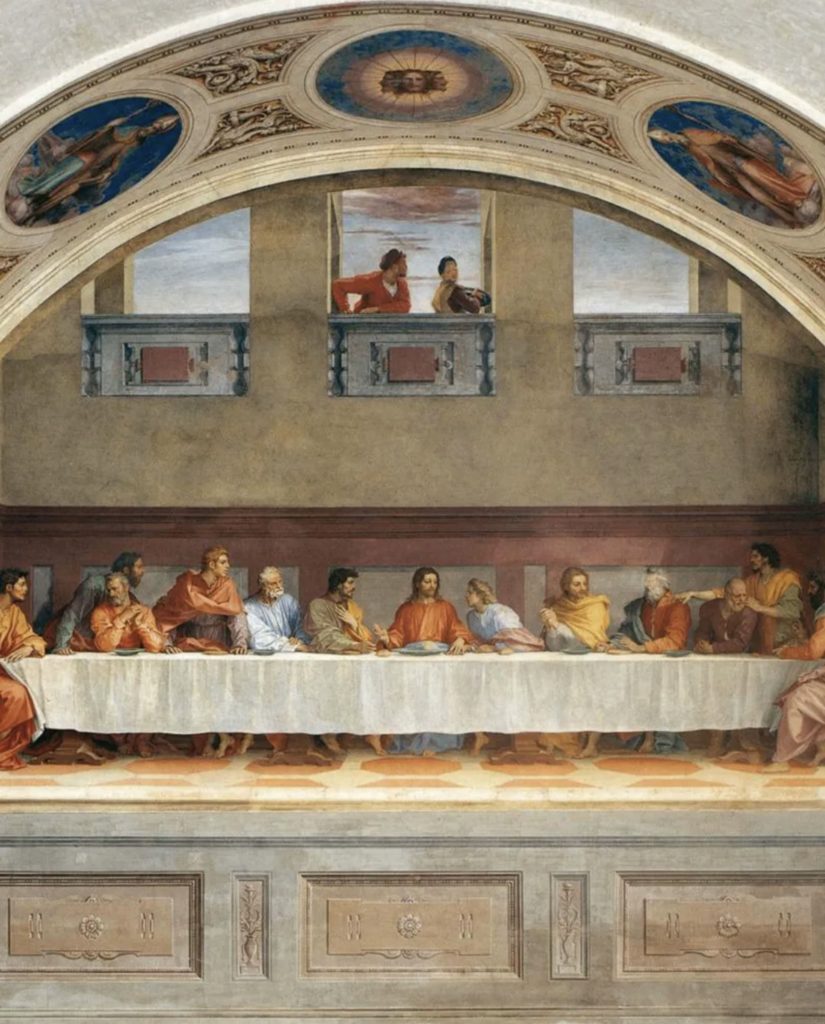
Art historian Giorgio Vasari described the painting as an “Endless majesty with its absolute grace of all the painted figures.” Experts rank del Sarto’s The Last Supper second only to Leonardo’s The Last Supper.
Del Sarto was a painter in the High Renaissance who was instrumental in the development of the Early Mannerism period.
This painting shows Del Sarto at his artistic maturity, with perfect composition and vivid expressive color.
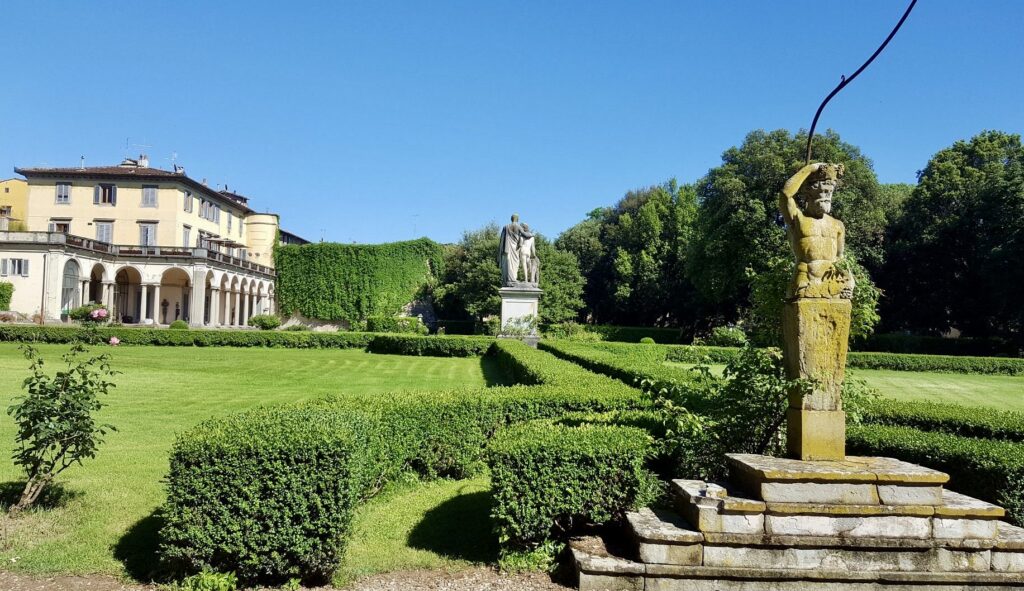
24. Torrigiani Garden
The Torrigiani Garden is a secret hidden gem in Florence. It covers nearly 17 acres and is the largest privately owned garden in Europe.
The garden is privately owned by two Torrigiani families: the Torrigiani di Santa Cristina and the Torrigiani Malaspina. They both have properties in the garden.
You can only peak behind the walls and visit on a guided tour with one of the owners, which must be arranged in advance.
A statue of Osiris greets you a the entrance. Once inside, you’ll find plants, trees, a nursery, a greenhouse, and a Neo-Gothic tower. The garden is also dotted with statuary.
I hope you’ve enjoyed my guide to the hidden gems of Florence. You may enjoy these other Florence travel guides and resources:
- 1 day itinerary for Florence
- 2 day itinerary for Florence
- 3 day itinerary for Florence
- Guide to the Uffizi Gallery
- Best Museums in Florence
- How To See Michelangelo’s David
- Guide to the Duomo Museum
- Guide to San Lorenzo and the Medici Chapel
- Guide to the Basilica of Santa Croce
- Guide to the Palazzo Vecchio
- How To Climb Brunelleschi’s Dome
- Guide to the Medici Palaces
If you’d like to explore off the beaten path Florence, pin it for later.

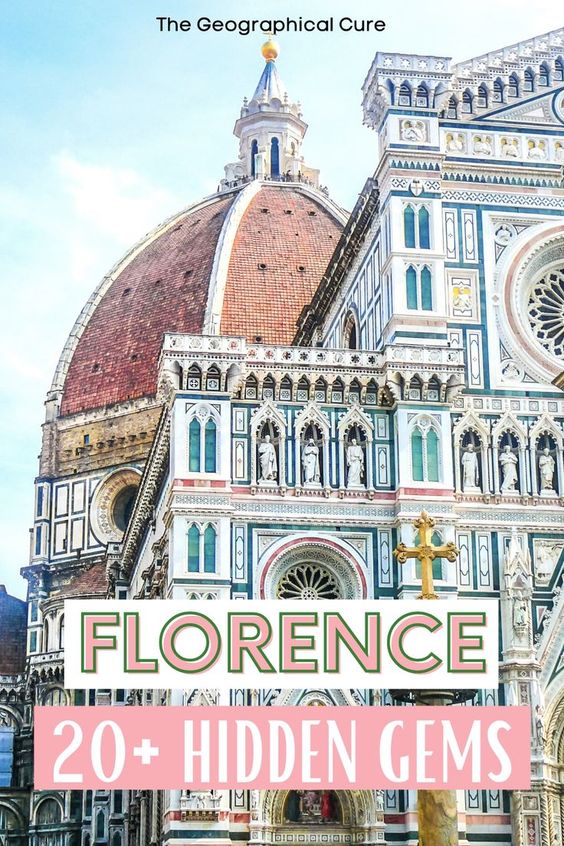
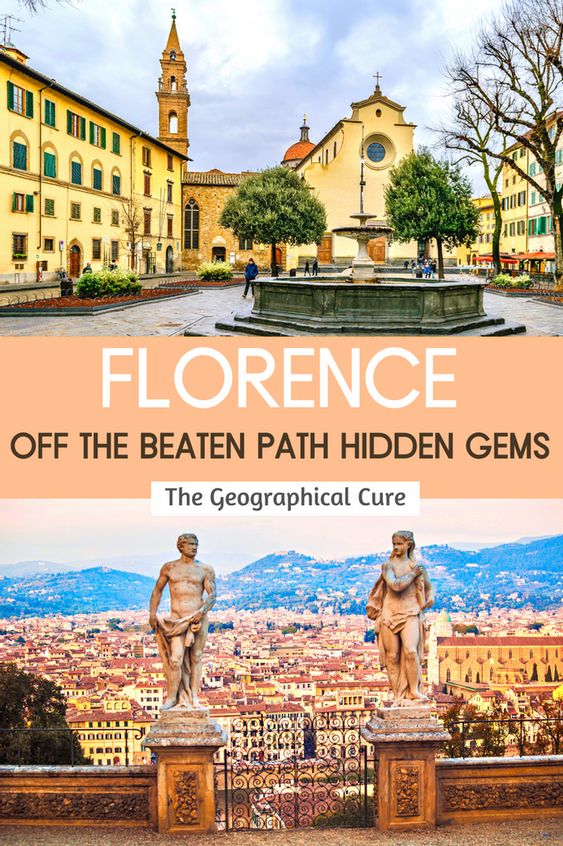
Love your suggestions for Florence! We have been there many times and were looking for other things to do. Thank you for these great tips!
You’re welcome! There’s always something new to do in Florence, even if it’s just a special art exhibition.